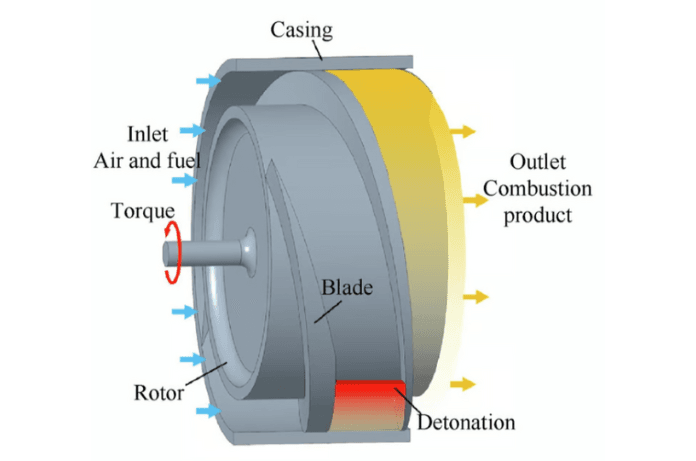In a groundbreaking innovation that could redefine modern warfare, Chinese scientists have successfully developed an advanced boron-based water ramjet engine. This remarkable feat was achieved within just two years of its proposal and has the potential to revolutionize hypersonic weapon technology.
Originally designed for hypersonic weapons, the engine has now been adapted to operate in two mediums air and water. The novel engine achieved 87% efficiency in laboratory tests, which were conducted in submarine mode. It can propel missiles at astonishing speeds through the air, and then seamlessly plunge into the sea, making it an unprecedented innovation in defense technology.
The Multi-Medium Engine: A Dual-Purpose Marvel
What makes this engine truly extraordinary is its ability to function as a cross-medium propulsion system. By using boron as its primary fuel, the engine can accelerate missiles to Mach 5 speeds in the air and maintain high velocities exceeding 200 knots underwater.
This is achieved by utilizing air and water as oxidizing agents, allowing the engine to sustain combustion in both environments. Laboratory tests have shown that the engine achieves an 87% combustion efficiency in submarine mode, meeting all requirements for practical use.
In 2022, scientists from the National University of Defence Technology (NUDT) in Changsha, Hunan province, proposed this innovative engine for underwater applications. The NUDT team envisions cross-medium vehicles powered by such engines flying at supersonic speeds for hundreds of kilometers before diving underwater to attack heavily fortified targets like aircraft carriers.
The Role of Boron in Hypersonic Technology
Boron, a lightweight metalloid, plays a pivotal role in this engine. Known for its high energy density, boron burns intensely when it reacts with oxygen, generating immense heat and thrust. This capability makes it ideal for powering scramjet engines and supersonic combustion ramjets used in advanced hypersonic weapons.
However, burning boron underwater posed a significant challenge. The NUDT team overcame this by employing a unique two-stage combustion process. This design ensures that the solid boron fuel gets a second chance to ignite, thereby boosting overall engine efficiency.
The research team also optimized the ratio of active metals like magnesium and aluminum in the fuel, enhancing boron’s ability to burn more thoroughly in water vapor. By simulating underwater conditions, these adjustments were tested in a ground laboratory.
Unmatched Performance: A Step Ahead of SpaceX
During laboratory tests, the engine demonstrated stable operation with a bright yellow flame near its nozzle, according to Professor Huang Liya, who led the project. The exhaust jet velocity exceeded Mach 3, and the engine achieved a specific impulse of 4,712 newton-seconds per kilogram.

To put this into perspective, this efficiency is one-third higher than SpaceX’s latest Raptor rocket engine, a feat that highlights the advanced capabilities of this boron-based technology.
The team plans to further enhance the engine by increasing the boron content in the solid propellant and improving combustion efficiency.
A New Era in Warfare
This innovation could alter the landscape of warfare. Current missile defense systems are unable to intercept such hypersonic, cross-medium weapons. Vehicles powered by this engine can travel vast distances at supersonic speeds in the air and seamlessly transition to underwater operations, targeting strategic assets with unmatched precision and speed.
The combination of boron-based fuel and water-oxidizing capabilities positions this technology as a game-changer for future defense systems.
Why Boron Holds the Key
Boron’s high energy density makes it a preferred choice for volume-limited propulsion systems like ramjet and scramjet engines. However, practical applications of boron as a fuel faced challenges until recently due to the native oxide layer on boron particles, which inhibits ignition and combustion.
In 2022, researchers reported the successful use of two-stage combustion for boron particles, enabling complete burning and demonstrating its feasibility for advanced propulsion systems. This breakthrough has opened new avenues for utilizing boron in military applications.
Key Challenges and Innovations
- Igniting Boron in Water:
The biggest challenge was ensuring boron combustion in an underwater environment. The team addressed this by adopting a two-stage combustion process and optimizing the injection volume of water vapor into the combustion chamber. - Stable Operation:
The engine maintained stable operation throughout tests, with consistent flame pressure and exhaust velocity, even in simulated underwater conditions. - Fuel Optimization:
By refining the fuel composition with active metals like magnesium and aluminum, the team ensured thorough combustion and enhanced engine efficiency.
Applications Beyond Warfare
While the immediate focus of this technology is military, the broader implications of boron-based engines extend beyond defense. Their high efficiency and adaptability could pave the way for innovations in aerospace, marine propulsion, and even commercial space exploration.
The Road Ahead
The development of this boron-based water ramjet engine is just the beginning. The NUDT team has validated its feasibility and proven its operational stability. The next steps include increasing boron content, further optimizing combustion processes, and exploring scaling-up production for practical deployment.
With no nation yet capable of intercepting such advanced hypersonic weapons, this innovation positions China at the forefront of next-generation defense technology.
The Future of Propulsion
The boron-based water ramjet engine is a testament to human ingenuity and technological progress. By overcoming the challenges of cross-medium propulsion, Chinese scientists have unlocked a new realm of possibilities in defense and beyond.

